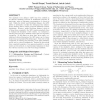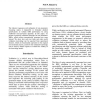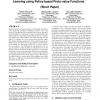886 search results - page 21 / 178 » Learning Distance Functions using Equivalence Relations |
EDBT
2011
ACM
13 years 1 months ago
2011
ACM
The quadratic form distance (QFD) has been utilized as an effective similarity function in multimedia retrieval, in particular, when a histogram representation of objects is used...
FLAIRS
2006
13 years 11 months ago
2006
The inherent vagueness and ambiguity of non-monotonic reasoning makes it impossible to formulate detailed specifications to validate KBS performance by using traditional test-case...
ATAL
2008
Springer
13 years 11 months ago
2008
Springer
Reinforcement Learning research is traditionally devoted to solve single-task problems. Therefore, anytime a new task is faced, learning must be restarted from scratch. Recently, ...
IROS
2008
IEEE
14 years 4 months ago
2008
IEEE
— Vehicle following can be achieved by minimizing the relative information (Kullback-Leibler or K-L distance), between the estimated poses of leader and follower vehicles by form...
SDM
2007
SIAM
13 years 11 months ago
2007
SIAM
We introduce a new approach for Clustering and Aggregating Relational Data (CARD). We assume that data is available in a relational form, where we only have information about the ...



